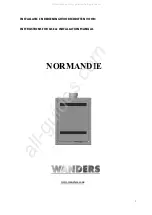
-4-
NEVER use gasoline, gasoline-type lantern fuel, kerosene, charcoal lighter fluid or similar liquids to start or “freshen up” a fire in
this heater. Keep all such liquids well away from the heater while in use. Additionally, never apply fire-starter to hot embers in
the stove. Do not use chemicals or fluids to start the fire. Do not burn flammable fluids such as gasoline, NAPHTHA or engine oil.
Adhere to all clearances to combustible material, as well as floor protection requirements, mentioned in this manual. Do
NOT store fuel closer than specified clearances to combustibles or within the space needed for loading the stove and ash
removal. This unit was designed for operation only with the loading door closed and tightly latched. Operating this unit with
the loading door latched loosely or open will allow excessive combustion air to reach the fire and will result in dangerously
high temperatures. High unit temperatures can damage the unit, void the warranty or ignite creosote deposited in the flue
system by previous, slow burning fires.
STARTING YOUR FIRE
• Be sure the air intake control on the door is fully open.
•
Place several sheets of rumpled paper in the center of the firebox, then place approximately 8 to 10 small pieces of
dry kindling over the top of the paper, forming a “tee-pee” shape. If you place any heating wood in the firebox at this
time, choose very small pieces. You may also choose solid “fire-starters” to help start your fire. Remember, NO flammable
liquids such as lighter fluid or gas may be used!
• To avoid back draft from cold air outside the structure, you should warm the chimney prior to igniting the wood in the
firebox. Twist a few sheets of paper into a torch shape, then light it and hold it as close as possible to the entry of the flue,
inside the combustion chamber, to warm the chimney. USE CAUTION so that you do not burn yourself. Once an updraft
into the flue is initiated, you may light your stove by lighting the paper and kindling tee-pee that is inside the firebox.
• Leave the stove door slightly opened for 5-10 minutes, or until good combustion is achieved.
•
DO NOT leave the fire while the door is opened. At this time you may close the door and progressively adjust the air
control to achieve the preferred intensity of the fire.
• Once you have a bed of embers, reload the unit with larger wood. For safety and best performance, you should keep
your wood load no higher than 6 inches.
•
Use the circular draft control on the stove door to regulate the intake air for your fire. We recommend installing a
magnetic thermometer on your stove pipe, approximately 18” (46 cm) above the stove’s surface. The ideal temperature
of the flue pipe is between 250° F and 500° F (121° C - 260° C). Below this range can encourage creosote buildup, and
above this range can waste heat and potentially lead to over-firing.
ASH REMOVAL
Inspect the firebox daily for ash accumulation. Ashes should be placed in a metal container with a tight fitting lid. The closed
container of ashes should be placed on a noncombustible floor or the ground, well away from all combustible materials,
pending final disposal. If the ashes are disposed of by burial in soil or otherwise locally dispersed, they should be retained in
the closed container until all cinders have been thoroughly cooled. Remember to store the stove with ashes cleaned from the
firebox, or premature rust and degradation of the firebox will occur. A small open container of a desiccant (i.e. cat litter) in
the stove can help prevent corrosion when the stove is not being used; be certain to remove it before transporting the stove
or building a fire. Never store your stove with ash in the firebox. The ash will draw moisture and your stove will rust.
Inspect the flue system to be sure it is properly intact. Inspect the pipe and spark arrestor, rain cap, etc. for creosote buildup,
and clean if necessary. Visually inspect any other parts (including accessories, options, etc.) for proper function.
CAUTION:
Remember that wood combustion consumes ambient oxygen; as mentioned previously, be sure to always have some sort
of an outside air intake such as a cracked door or opened window.
CAUTION:
Be sure to check the spark arrestor daily and clean as necessary, as a clogged spark arrestor can cause smoke to spill out
of the stove door or could even cause a fire in the stove pipe.
CAUTION:
The more you use the door draft to reduce air flow and/or use soft or moist wood, the more creosote buildup you will experience
in the stove pipe and spark arrestor. Be sure to check your stove pipe and the spark arrestor regularly for creosote, and clean
as necessary. DRY hardwoods burn the most efficiently and provide the most heat.
























